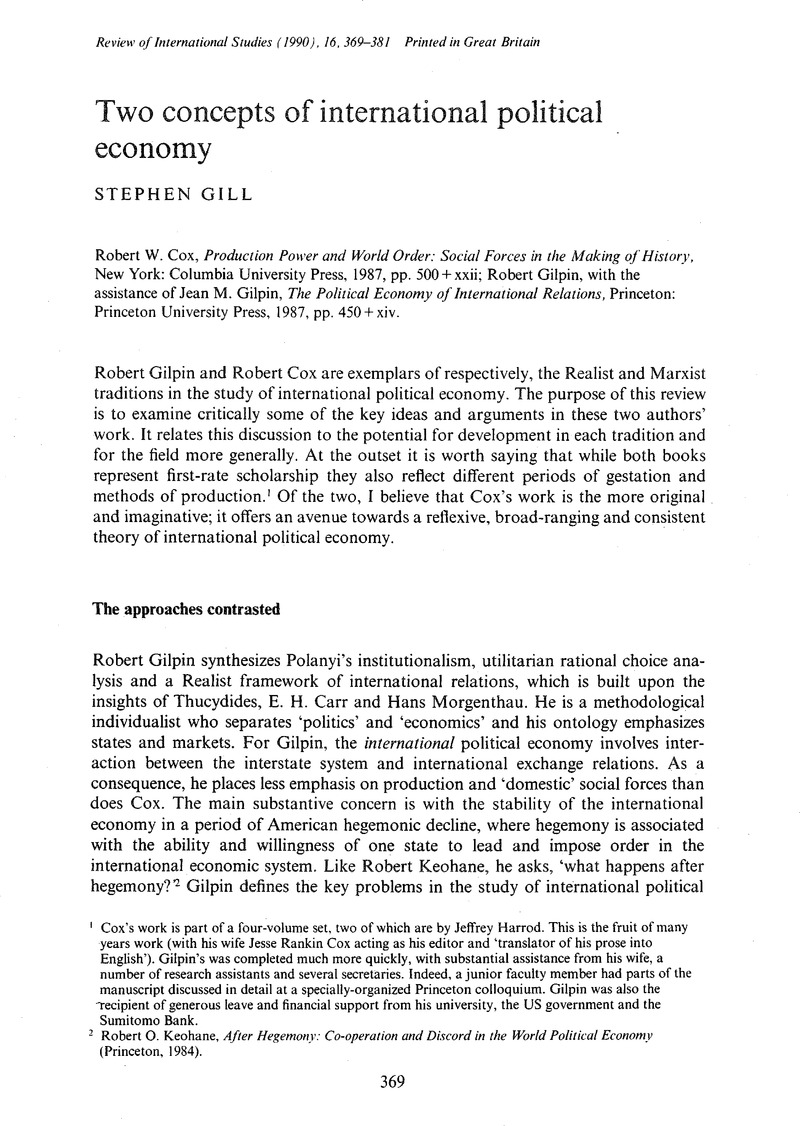Article contents
Two concepts of international political economy - Robert W. Cox, Production Power and World Order: Social Forces in the Making of History, New York: Columbia University Press, 1987, pp. 500+ xxii; - Robert Gilpin, with the assistance of Jean M. Gilpin, The Political Economy of International Relations, Princeton: Princeton University Press, 1987, pp. 450 + xiv.
Published online by Cambridge University Press: 26 October 2009
Abstract

- Type
- Review articles
- Information
- Copyright
- Copyright © British International Studies Association 1990
References
1 Cox's work is part of a four-volume set, two of which are by Jeffrey Harrod. This is the fruit of many years work (with his wife Jesse Rankin Cox acting as his editor and ‘translator of his prose into English'). Gilpin's was completed much more quickly, with substantial assistance from his wife, a number of research assistants and several secretaries. Indeed, a junior faculty member had parts of the manuscript discussed in detail at a specially-organized Princeton colloquium. Gilpin was also the ‘recipient of generous leave and financial support from his university, the US government and the Sumitomo Bank.
2 Keohane, Robert O., After Hegemony: Co-operation and Discord in the World Political Economy (Princeton, 1984)Google Scholar.
3 The other three volumes are: Harrod, Jeffrey, Power, Production and the Unprotected Worker (New York, 1987)Google Scholar; Harrod, , The Established Worker: Corporatist Social Relations (forthcoming, title provisional)Google Scholar and Cox, Robert W., Production Relations in Noncapitalist Development (forthcoming, title provisional)Google Scholar.
4 Gilpin, Robert, War and Change in World Politics (Cambridge, 1981)CrossRefGoogle Scholar.
5 Ashley, Richard K., ‘Untying the Sovereign State: a Double Reading of the Anarchy Problematique’ Millennium 17(1988), pp. 227–262CrossRefGoogle Scholar.
6 Gill, Stephen and Law, David, The Global Political Economy: Perspectives, Problems and Policies (Hemel Hempstead and Baltimore, 1988)Google Scholar. The latter concept implies a more integrated system of knowledge, production and exchange. This global concept includes the dialectical relations between capitalist and non-capitalist systems and states, ecological, ethical and other aspects of the whole.
7 Gilpin, , War and Change in World Politics, p. 7Google Scholar states this explicitly. The existentialist image I have in mind is Sartre's, J.-P.Huis ClosGoogle Scholar, where three incompatible characters are incarcerated in an eternal hell. It is not the flames and torpors which constitute this hell: merely the fact that each character cannot control the will(s) of the other(s). Love, tenderness and indeed permanent alliances are impossible under the perennial gaze of the other. The essentialism of the system is captured in the metaphor of Hell: all are in a permanent state of insecurity and fear of the other(s). For a succinct statement of Gilpin's other assumptions, see his ‘The Richness of the Tradition of Political Realism’, International Organisation, 38 (1984), pp. 287–304CrossRefGoogle Scholar.
8 Gilpin, Robert, The Political Economy of International Relations (Princeton, 1987), p. 10CrossRefGoogle Scholar.
9 Gilpin, , Political Economy of International Relations, p. 15Google Scholar.
10 Gilpin, , Political Economy of International Relations, p. 15Google Scholar; Polanyi, Karl, The Great Transformation: the political and economic origins of our times (Boston, 1957), p. 3Google Scholar.
11 Kindleberger, Charles P., The World In Depression, 1929–39 (Berkeley, 1973)Google Scholar.
12 Gilpin, , Political Economy of International Relations, pp. 151–165Google Scholar.
13 Gilpin, , Political Economy of International Relations, pp. 337Google Scholar ff.
14 For other key American interpretations of these questions, see Calleo, David P., Beyond American Hegemony: the future of the western alliance (Brighton, 1987)Google Scholar; Kennedy, Paul, The Rise and Fall of the Great Powers, Economic Change and Military Conflict from 1500 to 2000 (London, 1988)Google Scholar.
15 Gilpin, , Political Economy of International Relations, p. xivGoogle Scholar.
16 Gilpin, , Political Economy of International Relations, p. 35Google Scholar.
17 Gilpin, , Political Economy of International Relations, p. 400Google Scholar.
18 Gilpin, , Political Economy of International Relations, p. 292Google Scholar; Bunce, Valerie, ‘The Empire Strikes Back: The Evolution of the Eastern Bloc from a Soviet Asset to a Soviet Liability’ International Organisation 39 (1985), pp. 1–46CrossRefGoogle Scholar.
19 Gilpin, , Political Economy of International Relations, p. 294Google Scholar.
20 See for example, Frey, Bruno S., International Political Economics (Oxford, 1984)Google Scholar; Vroey, M. de, ‘A Regulation Approach to the Interpretation of the Contemporary Crisis’ Capital and Class 23 (1984), pp. 45–66CrossRefGoogle Scholar. Indeed Gilpin wrongly classifies Cox as a world systems theorist, see Political Economy of International Relations, pp. 68–69Google Scholar.
21 Gilpin, , Political Economy of International Relations, p. 25Google Scholar.
22 Waltz, Kenneth, Theory of International Relations (Reading, Mass., 1979)Google Scholar; Althusser, Louis, For Marx, (London, 1969) translated by Brewster, B.Google Scholar.
23 Kennedy, , The Rise and Fall of the Great PowersGoogle Scholar.
24 Cox, Robert W., Production, Power and World Order: Social Forces in the Making of History (New York, 1987), p. xGoogle Scholar.
25 Cox, , Production, Power and World Order, pp. 22–24Google Scholar.
26 See Gramsci, Antonio, Selections from the Prison Notebooks, Edited by Hoare, Quentin and Nowell-Smith, Geoffrey (London, 1971)Google Scholar.
27 Cox, , Production, Power and World Order, pp. 6–8Google Scholar, 357–8.
28 Cox, , Production, Power and World Order, pp. 355–391Google Scholar.
29 Cox, , Production, Power and World Order, pp. 279Google Scholar.
30 Cox, , Production, Power and World Order, pp. 253–254Google Scholar.
31 Gill, Stephen and Law, David, ‘Global Hegemony and the Structural Power of Capital’ International Studies Quarterly 33 (1989), pp. 475–499CrossRefGoogle Scholar.
32 For example, Mastudano, Michael, Lake, David A, and Ikenberry, G. John, ‘Towards a Realist Theory of State Action’, International Studies Quarterly 33 (1989) pp. 457–474CrossRefGoogle Scholar.
33 For example, after the fashion of Barraclough, Geoffrey, An Introduction to Contemporary History Harmondsworth, 1967)Google Scholar.
34 Hirsch, Fred, The Social Limits to Growth (London, 1976), pp. 27–39CrossRefGoogle Scholar.
- 6
- Cited by




